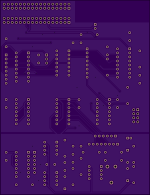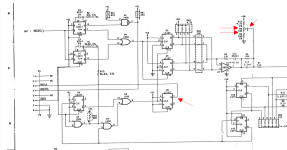NRoach44
Member
I've just obtained an OCC1 myself, but it's completely vanilla, with a 1.3 version ROM and no upgrades. Since I found the schematics for the upgrade in the Service manual for the computer I figured I'd challenge myself to reproduce it in KiCad.
I'm pretty confident I've reproduced what I can, but I would greatly appreciate any feedback, technical or otherwise, before I go and drop $90 on three boards that may or may not work!
I've put what I've got so far into gitlab, here: https://gitlab.com/NRoach44/occ1-dd-upgrade
My plan so far is to make a *electrically* accurate reproduction, and then once I'm happy with that, make one with a PC style pin header for Goteks.
The original schematics are page # 98 and 99 of https://util.nroach44.id.au/misc/occ1-dd/2F00040-00_Service2ndEdition_1983_DDSchematics.pdf
I've PDF'd the rework's schematics here: https://util.nroach44.id.au/misc/occ1-dd/occ1-dd-remaster-20220706.pdf
Finally, I have renders from OSHPark of the board:


I've made the board a bit more cramped to save on cost, currently it looks to be about $30 USD each, before components.
Any feedback welcome!
I'm pretty confident I've reproduced what I can, but I would greatly appreciate any feedback, technical or otherwise, before I go and drop $90 on three boards that may or may not work!
I've put what I've got so far into gitlab, here: https://gitlab.com/NRoach44/occ1-dd-upgrade
My plan so far is to make a *electrically* accurate reproduction, and then once I'm happy with that, make one with a PC style pin header for Goteks.
The original schematics are page # 98 and 99 of https://util.nroach44.id.au/misc/occ1-dd/2F00040-00_Service2ndEdition_1983_DDSchematics.pdf
I've PDF'd the rework's schematics here: https://util.nroach44.id.au/misc/occ1-dd/occ1-dd-remaster-20220706.pdf
Finally, I have renders from OSHPark of the board:


I've made the board a bit more cramped to save on cost, currently it looks to be about $30 USD each, before components.
Any feedback welcome!

